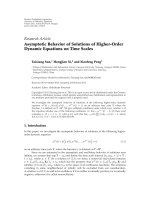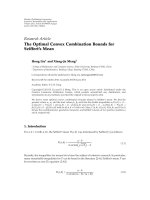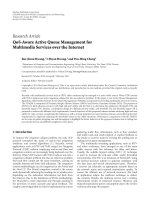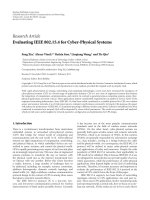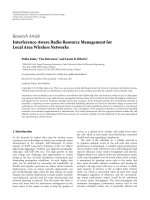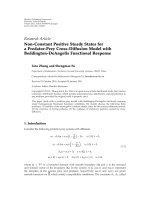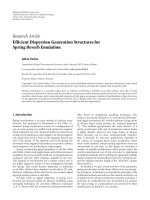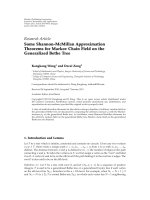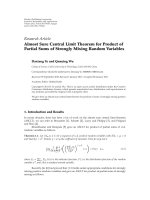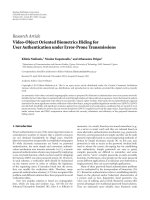báo cáo hóa học:" Research Article Accurate Bit Error Rate Calculation for Asynchronous Chaos-Based DS-CDMA over Multipath Channel" pptx
Bạn đang xem bản rút gọn của tài liệu. Xem và tải ngay bản đầy đủ của tài liệu tại đây (881.92 KB, 12 trang )
Hindawi Publishing Corporation
EURASIP Journal on Advances in Signal Processing
Volume 2009, Article ID 571307, 12 pages
doi:10.1155/2009/571307
Research Article
Accurate Bit Error Rate Calculation for Asynchronous
Chaos-Based DS-CDMA over Multipath Channel
Georges Kaddoum,
1, 2
Daniel Roviras,
3
Pascal Charg
´
e,
2
and Daniele Fournier-Prunaret
2
1
IRIT Laboratory, University of Toulouse, 2 rue Charles Camichel, 31071 Toulouse cedex, France
2
LATTIS Laboratory, University of Toulouse, 135 avenue de Rangueil, 31077 Toulouse cedex 4, France
3
LAETITIA Laboratory, CNAM Paris, 292 rue Saint-Martin, 75003 Paris, France
Correspondence should be addressed to Georges Kaddoum,
Received 21 January 2009; Revised 26 June 2009; Accepted 23 July 2009
Recommended by Kutluyil Dogancay
An accurate approach to compute the bit error rate expression for multiuser chaosbased DS-CDMA system is presented in this
paper. For more realistic communication system a slow fading multipath channel is considered. A simple RAKE receiver structure
is considered. Based on the bit energy distribution, this approach compared to others computation methods existing in literature
gives accurate results with low computation charge. Perfect estimation of the channel coefficients with the associated delays and
chaos synchronization is assumed. The bit error rate is derived in terms of the bit energy distribution, the number of paths, the
noise variance, and the number of users. Results are illustrated by theoretical calculations and numerical simulations which point
out the accuracy of our approach.
Copyright © 2009 Georges Kaddoum et al. This is an open access article distributed under the Creative Commons Attribution
License, which permits unrestricted use, distribution, and reproduction in any medium, provided the original work is properly
cited.
1. Introduction
Communication using chaos has attracted a great deal of
attention from many researchers for more than a decade.
Motivations of these studies remain to the advantages that
are offered by chaotic signals such as robustness in multipath
environments, resistance to jamming [1]. Chaotic signals
are non periodic, broadband, and difficult to predict and
to reconstruct. These are properties which coincide with
requirements for signal used in communication systems, in
particular for spread-spectrum communications and secure
communications [1, 2].
Many communication systems were inspired by the
synchronization results of Pecora and Carrol [3], focused
on analog modulation schemes with coherent receivers [4–
7]. Digital modulations using discrete signals and a coherent
receiver were introduced in [8]. Many others chaotic digital
modulation schemes were proposed and studied [9–11].
It has been found that digital schemes are comparatively
more robust than analog schemes in the presence of noise
and thus represent a more practical form of systems for
implementation. Direct application of chaos to conventional
direct-sequence spread-spectrum (DSSS) systems was also
reported on the code level [12, 13]. The basic principle
is to replace the conventional binary spreading sequences,
such as m-sequences or Gold sequences [14], by the chaotic
sequences generated by a discrete-time nonlinear map. The
advantage of using chaotic spreading sequences relies on the
fact that the spreaded signal is less vulnerable to interception.
Instead of applying analog chaotic sequences to spread data
symbols, Mazzini et al. proposed quantizing and periodically
repeating the chaotic time series for spreading. It was also
reported that systems using the periodic quantized sequences
have larger capacities and lower bit-error rates than those
using m-sequences and Gold sequences in a multiple-access
environment [15, 16]. A large literature exists also on chaotic
spreading sequences design [17] and optimization [18–20].
Among the various digital chaos-based communication
schemes, coherent chaos-shift-keying (CSK) and noncoher-
ent differential chaos-shift-keying (DCSK) schemes have
been most thoroughly analyzed [21–25]. Compared with
chaotic-sequence spread-spectrum modulation, CSK and
DCSK modulation schemes make use of analog chaotic wide-
band waveforms directly to represent the binary symbols.
2 EURASIP Journal on Advances in Signal Processing
Coherent systems like CSK and chaos-based DS-CDMA
require coherent correlators with the assumption that the
receiver is able to generate a locally synchronous chaotic
signal.
In order to compute the bit-error rate (BER) perfor-
mance, many various assumptions have been presented.
Because of these assumptions, computed BERs are generally
different from their true value. The simplest approximation
used in [26], for example, is to consider the transmitted
chaotic bit energy being constant. This approximation can
be reasonable when the considered spreading factors are
very large (symbol duration much greater than chaotic chip
duration). Nevertheless, for small or moderated spreading
factors these assumption yields to very imprecise BER
performance. In fact, because of the nonperiodic nature of
chaotic signals, the transmitted bit energy of chaos-based
DS-CDMA systems varies from one bit to another.
Another classical assumption is to use the Gaussian
approximation for the decision parameter at the correlator
output, [2, 20, 27, 28], by considering the sum of dependent
variables as a Gaussian variable. Tam et al. in [28]have
proposed a simple way of deriving the BER of the CSK
system by computing numerically the first two moments
of chaotic signal correlation functions. Since the real values
chaotic signals are generated from a deterministic generator,
the Gaussian approximation can be valid for high spreading
factors but suffers from precision for small ones [29].
A mathematical calculation of BER for single and mul-
tiuser chaos communication system was recently presented
by Lawrance et al. in [29, 30]. In their approach, they did
not use neither the constant bit energy approximation nor
the Gaussian assumption. Only additive channel noise and
multiple access interference noise follow, in their study, a
Gaussian distribution. Their approach takes into account the
dynamics properties of the chaotic sequence by integrating
the BER expression for a given chaotic map over all possible
chaotic sequences for a given spreading factor. This latter
method is compared to the BER computation under Gaus-
sian assumption in [29] and seems more realistic to match
the BER. But, as it is said in [30], the aim of the method
was not to give implementable procedures for realistic sized
systems.
Because previous presented approaches are not valid for
small spreading factors or have a higher complexity of cal-
culation, another accurate approach was recently developed
in [31–34] to compute the BER performance for single and
multiuser chaos-based DS-CDMA over an Additive White
Gaussian Noise (AWGN) channel. Numerical derivation of
BER performance over multipath channel is also studied in
[35]. The idea is to compute the Probability Density Function
(PDF) of the chaotic bit energy and to integrate BER over
all possible values of the PDF. The shape of the PDF bit
energy is a qualitative indication concerning expected BER
performances.
In this paper, an asynchronous coherent multiuser chaos-
based DS-CDMA system is studied and evaluated. For each
user a multipath channel is considered. Our system is quite
similar to the coherent CSK system. The analog chaotic
wideband waveform is used directly to spread the binary
symbols. In the following we will focus our study on BER
performance. For a similar studied system, the problem of
performance optimization was widely studied in [27, 36]. In
our paper, we are only interested by computing the analytical
performance of such a chaos-based DS-CDMA.
For a conventional DS-CDMA system under multipath
channel, an RAKE receiver is used to overcome the severe
consequences of the multipath fading channel. This receiver
consists of a bank of programmable correlators that correlate
each of the L received replicas of the same transmitted
signal by the corresponding locally generated code. These
codes are used to despread the data signals. After the
despreading process, the RAKE multiplies each replica by
the corresponding estimated complex valued conjugate path
gain (provided by the channel estimator) [14]. If the channel
estimation is perfect, and all the paths are independent,
the RAKE receiver with Maximum Ratio Combining (MRC)
becomes an optimum receiver in the sense of highest signal
to noise ratio [14].
In our system we assume that channel coefficients and
delay estimation are perfectly known at the receiver. Fur-
thermore we consider that the synchronization is achieved
and maintained by the system proposed in [37]. Multipath
propagation, correlation properties of spreading codes, and
the RAKE receiver are taken into account to derive the BER
expression, which is oriented to asynchronous environment.
Further, the approach adopted here can be valid for many
other chaotic communication systems.
This paper is organized as follows. Section 2 is dedicated
to the description of the emitter structure. In Section 3
the RAKE with the demodulation process is presented. The
statistical properties of multiuser and self interference noises
are evaluated, and BER integral formulations are established
also in Section 4. Section 5 presents the BER computation
methodologies. Section 6 is dedicated to the analytical BER
calculation. Section 7 reports some conclusive remarks.
2. Model of Multiuser Chaos-Based
DS-CDMA System
In this section, the configuration of the multiuser chaos-
based DS-CDMA system is presented in Figure 1.
2.1. Emitter Structure. Thestudiedsystemisachaos-based
DS-CDMA system with M asynchronous users. The data
information symbols of user m (s
(m)
i
=±1) with period T
s
are generated by uncorrelated sources, which are indepen-
dent one from another. Symbols of user m are spreaded by
a chaotic sequence x
(
m
)
(t). Chaotic sequences of all users
are generated using the same chaotic generator f (
·)with
different initial conditions. A new chaotic sample (or chip) is
generated every time interval equal to T
c
(x
(m)
k
= x
(
m
)
(kT
c
)):
x
(
m
)
k+1
= f
x
(
m
)
k
. (1)
Chaotic sequences generated from (1) have a common
mean μ
= E(x) and a common variance σ
2
x
.Itisalways
possible to offset the map in order achieve μ
= 0 without
EURASIP Journal on Advances in Signal Processing 3
Transmitter Channel Rake receiver of user m
Channel user 1
Channel user 2
Channel user M
Noise
Decision
.
.
.
s
(1)
i
x
(1)
iβ+k
s
(2)
i
x
(2)
iβ+k
s
(M)
i
x
(M)
iβ+k
.
.
.
x
(M)
iβ −
τ
(m)
0
T
c
+ k
x
(M)
iβ −
τ
(m)
1
T
c
+ k
x
(M)
iβ −
τ
(m)
L
m
T
c
+ k
T
s
T
s
T
s
i(T
s
) −τ
(m)
0
C
(m)
∗
0
i(T
s
) −τ
(m)
1
C
(m)
∗
1
i(T
s
) −τ
(m)
L
C
(m)
∗
L
m
s
(m)
i
Figure 1: Simplified baseband equivalent of a chaos-based DS-CDMA system with a multipath channel.
changing the dynamical properties of the map. Mean values
of all sequences are assumed equal to zero (μ
= 0) in this
paper. The spreading factor β is equal to the number of
chaotic samples in a symbol duration (β
= T
s
/T
c
).
2.1.1. Chaotic Generator. In this paper, a Piece-Wise Linear
map (PWL) is chosen as a chaotic generator sequence [38]:
⎧
⎨
⎩
z
k
= K|x
k
|+ φ
[
mod1
]
,
x
k+1
= sign
(
x
k
)(
2z
k
−1
)
.
(2)
This map depends on K and φ parameters. K is a positive
integer and φ (0 <φ<1 ) is a real number. Both can
be changed to produce different sequences, and the initial
condition x(0) will be chosen following the condition: 0 <
x(0) < 1/K. In addition, this map has a known PDF for
the root square of bit energy distribution. This PDF will be
used later in this paper in order to derive the analytical BER
expression. Without loss of generality, throughout the paper,
the PWL parameters are fixed as follows: (K
= 3, φ = 0.1).
The emitted signal of user m at the output of the
transmitter is
u
(
m
)
(
t
)
=
∞
i=0
β
−1
k=0
s
(
m
)
i
x
(
m
)
iβ+k
g
t −
iβ + k
T
c
,(3)
where g(t) is the pulse shaping filter; in this paper we have
chosen a rectangular pulse of unit amplitude on [0, T
c
], that
is,
g
(
t
)
=
⎧
⎨
⎩
1, 0 ≤ t<T
c
,
0, elsewhere.
(4)
In order to simplify the mathematical model of multiuser
and interuser interferences, we transformed the emitted
signal into to the following form:
u
(
m
)
(
t
)
=
+∞
w=0
s
(
m
)
w/β
x
(
m
)
w
g
(
t −wT
c
)
,(5)
where q rounds the real value of q to the lowest integer.
2.2. Channel Model. The channel through which the radio
wave transmits are transmitted is a multipath channel.
Multipath components are delayed copies of the original
transmitted wave traveling through a different echo path,
each with a different magnitude and time-of-arrival at the
receiver. The studied system is an uplink chaos-based DS-
CDMA system, where each user transmits its signal over its
own multipath channel.
The baseband equivalent impulse response of the nor-
malized channel of user m is
h
(
m
)
(
τ
)
=
L
m
l=0
C
(
m
)
l
δ
τ −τ
(
m
)
l
(6)
with
L
m
l=0
C
(
m
)
l
2
= 1,
(7)
where C
(m)
l
and τ
(m)
l
denote the coefficient and the delay of
the lth path of user m and δ(t) is the Dirac impulse. Without
loss of generality delays have been taken equal to multiple
values of T
c
.
4 EURASIP Journal on Advances in Signal Processing
0 0.5 1 1.5 2 2.5 3
0
0.2
0.4
0.6
0.8
1
1.2
1.4
Energie
PWL (K
=
3, φ
= 0.1)
Figure 2: Probability density functions of bit energy for PWL
chaotic sequence (β
= 10).
An additive white Gaussian noise is added to the received
signals. Let n(t) be this noise with a two-side power spectral
density given by
S
n
f
=
N
0
2
.
(8)
For convenience, we replace n(t)byanequivalentnoise
source n
(t)where
n
(
t
)
=
∞
i=0
ε
i
g
(
t −iT
c
)
,
(9)
where
{ε
i
} is an independent Gaussian random variables
with zero mean and variance:
σ
2
n
=
N
0
2T
c
.
(10)
The received signal is
r
(
t
)
=
M
n=1
L
n
l=0
C
(
n
)
l
u
(
n
)
t −τ
(
n
)
l
+ n
(
t
)
.
(11)
3. Multiuser Received Signal
In this paper we assume that the channel estimator of
the RAKE receiver estimates perfectly the delays and the
associated gains. In addition, the number of channel path of
each user is equal to the number of fingers at the associated
receiver.
3.1. Demodulation Process. The coherent multiuser chaos-
based DS-CDMA system is considered in this paper, only
the user’s own reference sequence is known exactly at the
receiver, and no information about other user’s reference
sequences is known. The decision variable of user m for
symbol i can be modelled by the sum of interest variable Z
(m)
i
and the different noise sources (ζ
(m)
i
+ ψ
(m)
i
):
D
(
m
)
i
= Z
(
m
)
i
+ ζ
(
m
)
i
+ ψ
(
m
)
i
.
(12)
The interest variable expression Z
(m)
i
is
Z
(
m
)
i
= T
c
L
m
l=0
s
(
m
)
i
C
(
m
)
l
2
β
−1
k=0
x
(
m
)
iβ+k
2
.
(13)
E
(i,m)
bc
= T
c
β−1
k
=0
(x
(m)
iβ+k
)
2
is the energy transmitted by user m
during its ith data symbol duration.
Z
(m)
i
carries the information bit to be retrieved. For
normalized channel coefficients the variable of interest is:
Z
(
m
)
i
= E
(
i,m
)
bc
s
(
m
)
i
.
(14)
The expression of the AWGN noise coming from the
channel after correlation with the chaotic sequence is
ζ
(
m
)
i
= T
c
L
m
r=0
C
(
m
)
∗
r
β
−1
k=0
x
(
m
)
iβ+k
n
iβ+k+τ
(
m
)
r
/T
c
.
(15)
The multiuser and self interference noise expressions are
ψ
(
m
)
i
= MUI
(
m
)
i
+SI
(
m
)
i
, (16)
ψ
(
m
)
i
= T
c
L
m
r=0
C
(
m
)
∗
r
iβ+β
−1
w=iβ+k
x
(
m
)
w
γ
(
m
)
w,i
+ α
(
m
)
w,i
, (17)
where
γ
(
m
)
w,i
=
M
n=1
n
/
=m
L
n
l=0
C
(
n
)
l
s
(
n
)
(w+(τ
(
m
)
r
−τ
(
n
)
l
)/T
c
)/β
x
(
n
)
w+(τ
(
m
)
r
−τ
(
n
)
l
)/T
c
, (18)
α
(
m
)
w,i
=
L
m
l=0
l
/
=r
C
(
m
)
l
s
(
m
)
(w+(τ
(
m
)
r
−τ
(
m
)
l
)/T
c
)/β
x
(
m
)
w+(τ
(
m
)
r
−τ
(
m
)
l
)/T
c
. (19)
4. BER Integral Form for Multiuser
Chaos-Based DS-CDMA
TheoverallBERoftheuserm takes the following form:
BER
(
m
)
= P
s
(
m
)
i
= +1
P
s
(
m
)
i
=−1 | s
(
m
)
i
= +1
+ P
s
(
m
)
i
=−1
P
s
(
m
)
i
= +1 | s
(
m
)
i
=−1
,
(20)
where
P
s
(
m
)
i
=−1 | s
(
m
)
i
= +1
=
P
D
(
m
)
i
< 0 | s
(
m
)
i
= +1
=
P
E
(
i,m
)
bc
+ ζ
(
m
)
i
+ ψ
(
m
)
i
< 0
,
P
s
(
m
)
i
= +1 | s
(
m
)
i
=−1
=
P
D
(
m
)
i
> 0 | s
(
m
)
i
=−1
=
P
−
E
(
i,m
)
bc
+ ζ
(
m
)
i
+ ψ
(
m
)
i
≥ 0
.
(21)
EURASIP Journal on Advances in Signal Processing 5
In the following section, we will develop our approach
to compute the bit error rate of the chaos-based DS-CDMA
system.
4.1. BER Analysis Approach. Inordertocomputethebit
error rate, the moments of first- and second-order of
different noise sources must be computed.
In (15), the noise samples n
k
and chaotic samples x
(m)
k
are
independent. After correlation with chaotic sequence, ζ
(m)
i
is
still a Gaussian random variable with zero mean and variance
equal to
Var
ζ
(
m
)
i
=
N
0
2
E
(
i,m
)
bc
. (22)
The Gaussian distribution of multiple-access interfer-
encehasbeenexaminedin[39] when a binary spreading
sequences of Markov chains are used. In our case, a real
value chaotic sequence is used to spread the data symbols like
in the chaos-based communication systems used in [2, 28–
30]. According to the central limit theorem, the sum of a
large number of random variables from different chaotic
sequences and from different delayed versions of the same
chaotic sequence follow the Gaussian distribution [2, Section
3.2.3] and in [29, 30]. Hence, γ
(m)
w,i
and α
(m)
w,i
terms in (17)can
be treated as Gaussian variables.
For (18), γ
(m)
w,i
is a zero mean Gaussian variable with (see
Appendix A)
E
γ
(
m
)
w,i
=
0,
Var
γ
(
m
)
w,i
=
E
γ
(
m
)
w,i
2
.
(23)
According to the statistical properties of chaotic
sequences mentioned in Appendix A,Itcanbeeasilydemon-
strated that the variance of γ
(m)
w,i
is
Var
γ
(
m
)
w,i
=
M
n=1
n
/
=m
L
m
l=0
C
(
n
)
l
2
σ
2
x
. (24)
Channel coefficients are normalized, and then variance
becomes
Var
γ
(
m
)
w,i
=
(
M
−1
)
σ
2
x
, (25)
where σ
2
x
is the mean power of the spreading chaotic
sequence. It can be also demonstrated that the mean energy
of a transmitted chaotic chip sequence x
k
is E
c
= T
c
σ
2
x
.
α
(m)
w,i
in (19) is a Gaussian random sequence (see
Appendix B)with
E
α
(
m
)
w,i
=
0, (26)
Var
α
(
m
)
w,i
=
L
m
l=0
l
/
=r
C
(
m
)
2
σ
2
x
.
(27)
Finally, multiuser interference and self-interference are
two independent zero mean Gaussian random variables with
variances (see Appendices A and B):
Var
MUI
(
m
)
i
=
L
m
r=0
C
(
m
)
r
2
=1
T
c
iβ+β
−1
w=iβ+k
x
(
m
)
w
2
=E
(
i,m
)
bc
(
M
−1
)
T
c
σ
2
x
=E
c
,
(28)
Var
SI
(
m
)
i
=
T
c
iβ+β
−1
w=iβ+k
x
(
m
)
w
2
=E
(
i,m
)
bc
L
m
r=0
C
(
m
)
r
2
L
m
l=0
l
/
=r
C
(
m
)
l
2
=1−
L
m
l
=0
C
(
m
)
l
4
T
c
σ
2
x
=E
c
.
(29)
Using (28)and(29), D
(m)
i
can be considered as a normal
random variable, with the following moments:
E
D
(
m
)
i
=
E
(
i,m
)
bc
s
(
m
)
i
, (30)
Var
D
(
m
)
i
=
E
(
i,m
)
bc
ξ
(
m
)
i
, (31)
where
ξ
(
m
)
i
=
N
0
2
+
(
M
−1
)
E
c
+
⎛
⎝
1 −
L
m
l=0
C
(
m
)
l
4
⎞
⎠
E
c
. (32)
According to the fact that data symbols of user m are
equiprobably distributed on {+1, −1} and by using (30)and
(31), it comes that the error probability of symbol i for user
m (with energy E
(i,m)
bc
)isP
(i,m)
er
:
P
(
i,m
)
er
= Q
⎛
⎜
⎝
E
(
i,m
)
bc
ξ
(
m
)
i
⎞
⎟
⎠
(33)
with Q(x)
=
+∞
x
(1/
√
2π)e
(
−u
2
/2
)
du.
It appears that the system performance depends on
the energy of the transmitted data symbol. Because of the
nonperiodic nature of the chaotic signals, the transmitted bit
energy using the chaos-based DS-CDMA systems varies from
one bit to another for the same user m. The total BER will be
evaluated by integrating P
er
over all possible values of the bit
6 EURASIP Journal on Advances in Signal Processing
−1 −0.5 0 0.5 1
−1
−0.8
−0.6
−0.4
−0.2
0
0.2
0.4
0.6
0.8
1
2
Real part
Imaginary par t
(a)
0 0.2 0.4 0.6 0.8 1
−100
−50
0
50
0 0.2 0.4 0.6 0.8 1
−15
−10
−5
0
5
Magnitude (dB)
Phase (degrees)
Nor malized frequency (×π rad/sample)
Nor malized frequency (
×π rad/sample)
(b)
Figure 3: (a) Zeros of H(z); (b) amplitude and phase responses of the channel.
energy E
bc
. The total BER for user m is expressed by
BER
chaos
=
+∞
0
Q
E
bc
ξ
(
m
)
p
(
E
bc
)
dE
bc
. (34)
5. BER Computation
In this section, we present two different methodologies to
compute BER expression of (34).
5.1. Numerical BER De rivation. Following expression (34)
it is necessary to get the bit energy distribution before
computing the BER. Figure 2 gives the histogram of the
bit energy for the PWL spreading sequence and for a
spreading factor β equalto10.ThehistogramofFigure 2
has been obtained using one million samples. From these
samples, energies of successive bits are calculated for a
given spreading factor. The bit energy is assumed to be
the output of a stationary random process [40]; hence
the histogram obtained in Figure 2 can be considered as a
good estimation of the probability density function. When
an analytical expression of the PDF is difficult to derive
(example of PWL in Figure 2), the analytical integration
of (34) seems intractable and the only way is to make
a numerical integration. Using the histogram of Figure 2
we can compute the BER of (34) by using the following
expression:
BER
chaos
≈
c
i=1
Q
⎛
⎜
⎝
E
(
i,m
)
bc
ξ
(
m
)
i
⎞
⎟
⎠
P
E
(
i,m
)
bc
, (35)
where c is the number of histogram classes and P(E
(i,m)
bc
)is
the probability of having the energy in intervals centered on
E
(i,m)
bc
. This approach can be applied for any type of chaotic
sequence with quite simple operations: histogram of the bit
energy for a given spreading factor β followed by a numerical
integration. In addition, this approach explores the dynamics
properties of chaotic sequence and gives results with very
high accuracy.
In order to show the accuracy of our computing
methodology, we compare simulation results together with
the numerical integration method. For all the simulations,
the number of users is taken arbitrary. In our simulations
the number of users is fixed to M
= 8 for various spreading
factor β
= 20; 40; 80; 160; 320. All chaotic sequences are
normalized (E(x
(
m
)
2
) = 1). In addition, all users use the same
channel h to transmit their signals. The impulse response of
the channel used for transmission is
h
(
t
)
= 0.6742δ
(
t
)
+0.6030δ
(
t −T
c
)
+0.4264δ
(
t
−2T
c
)
.
(36)
The characteristics of the channel are shown in Figure 3.
It has two zeros inside the unit circle. The amplitude response
of the channel presents a deep fading and the phase response
is nonlinear.
Figure 4 gives simulation results together with the
numerical integration method of the BER for various
spreading factor plus the performance corresponding to
the monouser BPSK case over an AWGN channel. This
performance can be considered as a lower bound for the
chaos-based DS-CDMA system because the transmitted bit
energy is constant [31]. Computed BERs on Figure 4 are
obtained by using the histograms of Figure 2 together with
(35). The perfect match between simulation results and our
numerical method confirms the accuracy of this approach
based on the bit energy distribution. In addition, the good
estimation of the BER for high E
b
/N
0
confirms the validity
of the Gaussian distribution of the multiuser and self
interference noise.
For a DS-CDMA system low spreading factor has a
limited benefit. For a low spreading factor (β
= 20)
EURASIP Journal on Advances in Signal Processing 7
Lower bound BPSK over AWGN channel
Simulation
Computed BER
BER
10
−4
10
−3
10
−2
10
−1
10
0
02468 10 12 14 16
E
b
/N
0
(dB)
M = 8, β = 20
M
= 8, β = 40
M
= 8, β = 80
M = 8, β = 160
M = 8, β = 320
Figure 4: Numerical computation and simulated BER for M = 8
and β
= 20, 40, 80,160,320.
0 0.2 0.4 0.6 0.8 1
0
0.5
1
1.5
2
2.5
3
3.5
4
4.5
PWL histogram
Rice
Nakagami
Figure 5: Approximation of the PDF associated to the PWL by a
normalized root-square-energy histogram (K
= 3, φ = 0.1, β = 10).
multiuser interference is high, and the bit energy dispersion
is large which implies a poor performances. To improve
the performance of the system, it is necessary to increase
the spreading factor. When we increase the spreading factor
the dispersion of the bit is lower [31] and the multiuser
interference is small.
5.2. Analytical BER Derivation. To get the analytical expres-
sion (34) it is necessary to have firstly the analytical expres-
sion of the PDF of the bit energy distribution and secondly
to compute the integral of (34). Analytical expression of the
PDF of (34)seemsdifficult to derive because chaotic samples
are not totally independent.
Inordertocompute(34), two integral expressions of
BER can be considered:
BER
chaos
=
+∞
0
Q
⎛
⎝
2V
2ξ
(
m
)
i
⎞
⎠
p
(
V
)
dV,
(37)
where V
= E
(i,m)
bc
and
BER
chaos
=
+∞
0
Q
⎛
⎝
2Y
2
2ξ
(
m
)
i
⎞
⎠
p
(
Y
)
dY
, (38)
where Y
=
E
(i,m)
bc
Now, considering the expression (38)ofBER,onecan
note that it has the same form than the expression of the BER
obtained in the framework of mobile radio channels. Indeed,
for a BPSK transmission on a radio channel with gain λ, the
BERisexpressedas
BER
Radio
channel
=
+∞
0
Q
⎛
⎝
2λ
2
2ξ
(
m
)
i
Eb
⎞
⎠
p
(
λ
)
dλ
. (39)
Closed form expressions are available for (39) in the
case of channels following Rayleigh [41], Nakagami [42], or
Rice distributions [43]. Since expression (38) is similar to
expression (39), these previous results on (39)canbeusedfor
getting an analytical form of integral (38). Expression (37)
does not allow to obtain a similar comparison, and to take
advantage of existing integration results, one should then
resort to numerical integration, as discussed in Section 5.1.
The objective of this section consists of deriving an analytical
expression of BER. Consequently, one will only focus on
expression (38).
5.3. PDF E stimation of Root Square Energy. The PDF of
the root square energy is fundamental in order to solve
(38). The analytical derivation of the PDF seems intractable
because of the difficulty to solve correlation integral. One
proposes then to approximate this distribution by one of
the three distributions (Rayleigh, Rice, and Nakagami) which
will allow us to make use of the existing results on the
computation of (39) to derive a closed-form expression of
(38). This approximation has been investigated by plotting
the histogram of the variable Y. The PDF shape associated
to the PWL in Figure 5 gets the possibility to test the two
candidates: Rice and Nakagami PDF.
The histogram of the root square bit energy obtained
for one million samples of the PWL sequence is shown
in Figure 5. We have tried to fit it by classical PDF laws.
Figure 5 shows Rice and Nakagami-estimated PDF. The Chi-
Square Goodness-of-Fit test confirms the fit for the two
laws. Nevertheless, Chi-Square test gives priority to the Rice
distribution (see Figure 6).
8 EURASIP Journal on Advances in Signal Processing
0.15 0.2 0.25 0.3 0.35 0.4 0.45 0.5
0.2
0.4
0.6
0.8
1
1.2
PWL histogram
Rice
Nakagami
Figure 6: Zoom of the PDFs in the Figure 5.
6. Analy tical BER Calculation
This section provides an expression of the BER by approxi-
mating the PDF energy with the Rice distribution.
6.1. Rice Distribution Parameters. R
=
E
(i,m)
bc
is a random
variable following a Rice distribution P
R
(r). The General
Rice distribution function is defined in Appendix C.1.
General Rice distribution parameters are given by [43]
Ω
= E
R
2
; γ =
Var
R
2
(
Ω
)
2
.
(40)
6.2. Parameters Estimation of the Rice Distribution. To h a v e
an analytical BER expression, the parameters of the Rice
distribution should be derived from the parameters of the
PWL sequence. Parameters given in expression (40)ofRice
distribution are given by
R
2
= E
(
i,m
)
bc
= T
c
β
−1
k=0
x
(
m
)
iβ+k
2
,
(41)
where x
(m)
iβ+k
can be seen as a random signal uniformly
distributed on the interval [
−1, +1] (see [38]). x
(m)
iβ+k
has a
zero mean and its variance is 1/3. Then the scale parameter
Ω is given by
Ω
= E
R
2
=
T
c
β
−1
k=0
E
x
(
m
)
iβ+k
2
=
T
c
β
3
.
(42)
Vari an ce o f R
2
is then
V
R
2
= E
R
2
2
−
T
c
β
3
2
(43)
02468 10 12 14 16
E
b
/N
0
(dB)
Lower bound BPSK over AWGN channel
Simulation
Analytical BER for Rice distribution
M
= 8, β = 20
BER
10
−4
10
−3
10
−2
10
−1
10
0
M = 8, β = 40
M = 8, β = 80
M
= 8, β = 160
M = 8, β = 320
Figure 7:SimulatedBERandanalyticalBERexpressionforRice
distribution for M
= 8andβ = 20,40,80,160,320.
with
E
R
2
2
=
βT
2
c
5
+2T
2
c
β
−1
n=1
β −n
E
x
(
m
)
iβ+k
2
x
(
m
)
iβ+k+n
2
,
(44)
where E(x
(m)
iβ+k
2
x
(m)
iβ+k+n
2
) is estimated using the PWL chaotic
sequence. Then γ can be obtained by (40)(Appendix C.1).
6.3. Analytical Expression of the BER. Following results of
[43] the analytical BER is given:
BER
PWL
β
=
Q
(
u, v
)
−
1
2
⎡
⎣
1+
d
1+d
⎤
⎦
exp
−
u
2
+ v
2
2
I
0
(
uv
)
,
(45)
where the parameters u, v, Q(
·, ·)andI
0
are given in
Appendix C.2.
In simulations, the same parameters have been taken
as before in the numerical integration. BER obtained using
the analytical expression of (45) and the ones given by
Monte Carlo simulations are compared in Figure 7.The
lower bound BER of chaos-based communication system
is also plotted for reference. It clearly appears in Figure 7
that we have a perfect match between simulations and the
analytical results. Expression (45) can thus be used for all
types of spreading factors even for very small ones.
7. Conclusion
In this paper we have proposed a new simple approach
to compute BER for asynchronous chaos-based DS-CDMA
systems over multipath channel. Because of the nonpe-
riodic and the deterministic nature of chaotic sequence,
EURASIP Journal on Advances in Signal Processing 9
the constant energy assumption or the standard Gaussian
approximation of the decision variable in the output of
correlator leads to inaccurate results in the BER expression.
In our approach, neither the constant bit energy assumption,
nor the Gaussian approximation for the decision variable is
considered to compute the performance of the chaos-based
communication system. The BER expression is computed
in terms of the energy distribution, the number of paths,
the noise variance, and the number of users. In order
to study only the performance of the system, a perfect
synchronization of the chaos is assumed, and we assume that
channel coefficients and delay estimation are known in the
receiver. The statistics of different noise sources were studied,
and the means and variances were evaluated. The Gaussian
distribution of the interfering noise is approximated thanks
to the central limit theorem. Two methodologies are con-
sidered to derive the BER expression. Firstly, when the PDF
of the bit energy has an irregular shape, only numerical
integration method is possible in order to compute the BER.
This numerical approach can be applied for a large chaos-
based communication system and for any type of chaotic
sequences independent from the initial condition of the
sequence. Secondly, in special cases, when the distribution
of the root square bit energy has a known distribution
(Rice, Nakagami or Rayleigh), the analytical BER expression
can be easily computed. For the PWL chaotic map, such
an analytical expression has been obtained with perfect
match with simulation. The analytical expression of BER for
multiuser DS-CDMA over Rayleigh channel is under study.
Appendices
A. Proof of (25) and (28)
The term γ
(m)
w,i
is given by
γ
(
m
)
w,i
=
M
n=1
n
/
=m
L
n
l=0
C
(
n
)
l
s
(
n
)
(w+(τ
(
m
)
r
−τ
(
n
)
l
)/T
c
)/β
x
(
n
)
w+(τ
(
m
)
r
−τ
(
n
)
l
)/T
c
. (A.1)
and so on γ
(m)
w,i
is the sum of different zero mean chaotic
sequences. These chaotic sequences are obtained from dif-
ferent users and from different delayed version of the same
chaotic sequence. Different chaotic sequences generated
from the same generator with different initial conditions
and the delayed version of the same chaotic sequence are
uncorrelated [1, 29].
Because the mean of the chaotic sequences is equal to
zero, the variance of γ
(m)
w,i
is
Var
γ
(
m
)
w,i
=
E
γ
(
m
)
w,i
2
−
E
γ
(
m
)
w,i
2
=0
,
Var
γ
(
m
)
w,i
=
E
γ
(
m
)
w,i
2
,
(A.2)
where
Var
γ
(
m
)
w,i
=
E
⎛
⎜
⎜
⎜
⎜
⎜
⎝
C
(
1
)
0
s
(
1
)
(w+(τ
(
m
)
r
−τ
(
1
)
0
)/T
c
)/β
x
(
1
)
w+(τ
(
m
)
r
−τ
(
1
)
0
)/T
c
+ ···+ C
(
1
)
L
1
s
(
1
)
(w+(τ
(
m
)
r
−τ
(
1
)
L
1
)/T
c
)/β
x
(
1
)
w+(τ
(
m
)
r
−τ
(
1
)
L
1
)/T
c
+
C
(
2
)
0
s
(
2
)
(w+(τ
(
m
)
r
−τ
(
1
)
0
)/T
c
)/β
x
(
2
)
w+(τ
(
m
)
r
−τ
(
1
)
0
)/T
c
+ ···+ C
(
2
)
L
2
s
(
2
)
(w+(τ
(
m
)
r
−τ
(
2
)
L
2
)/T
c
)/β
x
(
2
)
w+(τ
(
m
)
r
−τ
(
2
)
L
2
)/T
c
+
C
(
M
)
0
s
(
M
)
(w+(τ
(
m
)
r
−τ
(
1
)
0
)/T
c
)/β
x
(
M
)
w+(τ
(
m
)
r
−τ
(
1
)
0
)/T
c
+ ···+ C
(
M
)
L
M
s
(
M
)
(w+(τ
(
m
)
r
−τ
(
M
)
L
M
)/T
c
)/β
x
(
M
)
w+(τ
(
m
)
r
−τ
(
M
)
L
M
)/T
c
2
⎞
⎟
⎟
⎟
⎟
⎟
⎠
(A.3)
Because the chaotic samples of the PWL sequence have
averylowcorrelation[38], it was proven in [29] that for
one dimension recurrence chaotic map the mean function
of the product of two chaotic samples denoted by E[x
k
x
e
]
in the case of e
= j + k for a positive integer j is equal
to zero. After developing the expression (A.3) the means of
the terms having the form mentioned in (A.4)areequalto
zero:
E
C
(
n
)
k
s
(
n
)
(w+(τ
(
m
)
r
−τ
(
n
)
k
)/T
c
)/β
x
(
n
)
w+(τ
(
m
)
r
−τ
(
n
)
k
)/T
c
×C
(
n
)
e
s
(
n
)
(w+(τ
(
m
)
r
−τ
(
n
)
e
)/T
c
)/β
x
(
n
)
w+(τ
(
m
)
r
−τ
(
n
)
e
)/T
c
=
0.
(A.4)
Since the chaotic sequences generated from a common
generator with different initials conditions are uncorrelated,
the terms having the form mentioned in (A.5) are also equal
to zero:
E
C
(
n
)
k
s
(
n
)
(w+(τ
(
m
)
r
−τ
(
n
)
k
)/T
c
)/β
x
(
n
)
w+(τ
(
m
)
r
−τ
(
n
)
k
)/T
c
×C
(p)
j
s
(p)
(w+(τ
(
m
)
r
−τ
(
p
)
j
)/T
c
)/β
x
(p)
w+(τ
(
m
)
r
−τ
(
p
)
j
)/T
c
⎞
⎠
=
0.
(A.5)
Finally, only the following terms of (A.6)arenotequalto
zero:
E
C
(
n
)
l
2
s
(
n
)
(w+(τ
(
m
)
r
−τ
(
n
)
l
)/T
c
)/β
x
(
n
)
w+(τ
(
m
)
r
−τ
(
n
)
l
)/T
c
2
. (A.6)
After simplification, it can be easily demonstrated that
the variance of γ
(m)
w,i
is
Var
γ
(
m
)
w,i
=
M
n=1
n
/
=m
L
m
l=0
C
(n)
l
2
σ
2
x
. (A.7)
10 EURASIP Journal on Advances in Signal Processing
For normalized channel coefficients the variance is
Var
γ
(
m
)
w,i
=
(
M
−1
)
σ
2
x
. (A.8)
For the global variance MUI
(m)
i
of user m is
Var
MUI
(
m
)
i
=
Var
⎛
⎜
⎜
⎝
T
c
L
m
r=0
C
(
m
)
∗
r
iβ+β
−1
w=iβ
x
(
m
)
w
A
[γ
(
m
)
w,i
]
B
⎞
⎟
⎟
⎠
. (A.9)
The terms A and B in the expression (A.9) are inde-
pendent because the different chaotic sequences of different
users are uncorrelated. For normalized channel coefficients
the global variance MUI
(m)
i
of user m is:
Var
MUI
(
m
)
i
=
T
c
iβ+β
−1
w=iβ
x
(
m
)
w
2
=E
(
i,m
)
bc
(
M
−1
)
T
c
σ
2
x
=E
c
(A.10)
The variance MUI
(m)
i
of the multiuser interference is:
Var
MUI
(
m
)
i
=
(
M
−1
)
E
c
E
(
i,m
)
bc
(A.11)
B. Proof of (27) and (29)
The term α
(m)
w,i
is given by
α
(
m
)
w,i
=
L
m
l=0
l
/
=r
C
(
m
)
l
s
(
m
)
(w+(τ
(
m
)
r
−τ
(
m
)
l
)/T
c
)/β
x
(
m
)
w+(τ
(
m
)
r
−τ
(
m
)
l
)/T
c
.
(B.1)
α
(m)
w,i
is the sum of different delayed replicas of the same
chaotic sequence multiplied by their correspondent channel
coefficients, referring to the statistical properties mentioned
in Appendix A and in [29, 38].
The mean α
(m)
w,i
is equal to zero and the variance is
Var
α
(
m
)
w,i
=
E
α
(
m
)
w,i
2
. (B.2)
By developping the expression E(
|α
(m)
w,i
|
2
) only the terms
taking the forms
|C
(m)
l
|
2
E(|x
(m)
w+(τ
(m)
r
−τ
(m)
l
)/T
c
|)arenotequalto
zero. We can easily prove that the variance of α
(m)
w,i
is
Var
α
(
m
)
w,i
=
L
m
l=0
l
/
=r
C
(
m
)
l
2
σ
2
x
.
(B.3)
For the global variance SI
(m)
i
we have:
Var
SI
(m)
i
=
Var
⎛
⎜
⎜
⎝
T
c
L
m
r=0
C
(m)∗
r
iβ+β
−1
w=iβ
x
(
m
)
w
A
α
(
m
)
w,i
B
⎞
⎟
⎟
⎠
. (B.4)
The terms A and B in the expression (B.4) are inde-
pendent because the different delayed versions of a chaotic
sequence are uncorrelated. For normalized channel coeffi-
cients the global SI
(m)
i
variance of user m is
Var
SI
(
m
)
i
=
T
2
c
iβ+β
−1
w=iβ
x
(
m
)
w
2
L
m
r=0
C
(
m
)
r
2
L
m
l=0
l
/
=r
C
(
m
)
l
2
σ
2
x
,
(B.5)
Var
SI
(
m
)
i
=
E
c
E
(
i,m
)
bc
L
m
r=0
C
(
m
)
r
2
L
m
l=0
l
/
=r
C
(m)
l
2
D
.
(B.6)
In order to simplify the expression (B.6), the term D can
be expressed by
D
=
C
(
m
)
o
2
C
(
m
)
1
2
+
C
(
m
)
2
2
+ ···+
C
(
m
)
L
m
2
+
C
(
m
)
1
2
C
(
m
)
0
2
+
C
(
m
)
2
2
+ ···+
C
(
m
)
L
m
2
+ ···
+
C
(
m
)
L
m
2
C
(
m
)
0
2
+
C
(
m
)
1
2
+ ···+
C
(
m
)
L
m−1
2
,
(B.7)
where
D
=
C
(
m
)
o
2
1 −
C
(
m
)
0
2
+
C
(
m
)
1
2
1 −
C
(
m
)
1
2
+ ···
+
C
(
m
)
L
m
2
1 −
C
(
m
)
L
m
2
=
⎡
⎢
⎢
⎣
C
(
m
)
o
2
+
C
(
m
)
1
2
+ ···+
C
(
m
)
L
m
2
=1
−
C
(
m
)
o
4
−
C
(
m
)
1
4
−···−
C
(
m
)
L
m
4
.
(B.8)
Finally, the variance expression SI
(m)
i
of user m is
Var
SI
(
m
)
i
=
E
c
E
(
i,m
)
bc
⎛
⎝
1 −
L
m
l=0
C
(
m
)
l
4
⎞
⎠
. (B.9)
EURASIP Journal on Advances in Signal Processing 11
C.
C.1. General Rice Distribut ion Function. The general Rice
distribution is given by
P
R
(
r
)
=
⎧
⎪
⎪
⎪
⎪
⎪
⎪
⎪
⎪
⎪
⎪
⎪
⎪
⎪
⎨
⎪
⎪
⎪
⎪
⎪
⎪
⎪
⎪
⎪
⎪
⎪
⎪
⎪
⎩
2
(
K
r
+1
)
r
Ω
exp
−
K
r
−
(
K
r
+1
)
r
2
Ω
×
I
0
⎛
⎝
2
K
r
(
K
r
+1
)
Ω
r
⎞
⎠
if r ≥ 0
0ifr<0
(C.1)
where r
≥ 0, K
r
≥ 0, Ω ≥ 0
The parameters of Rice distribution are given by [43]
Ω
= E
R
2
; γ =
Var
R
2
(
Ω
)
2
. (C.2)
The shape parameter K
r
can be expressed in terms of γ
explicitly as [44]
K
r
=
1 − γ
1 −
1 − γ
. (C.3)
By defining the new variables: σ
2
= Ω/2(K
r
+1),and
α
2
= K
r
Ω/(K
r
+ 1), the new PDF expression is obtained [44]
by a simple change of variable in (C.1)
p
R
(
r
)
=
⎧
⎪
⎪
⎨
⎪
⎪
⎩
r
σ
2
exp
−
r
2
+ α
2
2σ
2
I
0
αr
σ
2
,ifr ≥ 0,
0, elsewhere.
(C.4)
C.2. The Parameters of BER over Rician Channel. The
different parameters of the analytical BER expression of (45)
are
u
=
γ
2
r
1+2d −2
d
(
d +1
)
2
(
1+d
)
,
v
=
γ
2
r
1+2d +2
d
(
d +1
)
2
(
1+d
)
,
σ
2
=
Ω
2
(
K
r
+1
)
, α
2
=
KΩ
(
K
r
+1
)
,
γ
2
r
=
α
2
2σ
2
, d = σ
2
Eb
ξ
(
m
)
,
(C.5)
where Eb is the constant bit energy before spreading, ξ
(
m
)
is
the sum of variances of different noises given in (32).
Q(., .) is the Marcum Q-function given by [43]
Q
α, β
=
1
α
M−1
∞
β
x
M
e
−(x
2
+α
2
)/2
I
M−1
(
αx
)
dx,
(C.6)
and I
n
(x) is a modified Bessel function of the first kind.
References
[1] P. Stavroulakis, Chaos Applications in Telecommunications,
CRC Press, New York, NY, USA, 2006.
[2] F.C.M.LauandC.K.Tse,Chaos-Based Digital Communica-
tion Systems, Springer, New York, NY, USA, 2003.
[3] L. M. Pecora and T. L. Carroll, “Synchronization in chaotic
systems,” Physical Review Letters, vol. 64, no. 8, pp. 821–824,
1990.
[4] K. M. Cuomo, A. V. Oppenheim, and S. H. Strogatz, “Syn-
chronization of lorenzbased chaotic circuits with aplication to
communications,” IEEE Transactions on Circuits and Systems,
vol. 40, pp. 626–633, 1993.
[5] K. M. Cuomo and A. V. Oppenheim, “Circuit implementation
of synchronized chaos with applications to communications,”
Physical Review Letters, vol. 71, no. 1, pp. 65–68, 1993.
[6] L. Kocarev and U. Parlitz, “General approach for chaotic syn-
chronization with applications to communication,” Physical
Review Letters, vol. 74, no. 25, pp. 5028–5031, 1995.
[7] L.M.Pecora,T.L.Carroll,G.A.Johnson,D.J.Mar,andJ.F.
Heagy, “Fundamentals of synchronization in chaotic systems,
concepts, and applications,” Chaos, vol. 7, no. 4, pp. 520–543,
1997.
[8] U. Parlitz, L. O. Chua, L. Kocarev, K. S. Halle, and A. Shang,
“Transmission of digital signals by chaotic synchronization,”
International Journal of Bifurcation and Chaos, vol. 2, pp. 973–
947, 1992.
[9] C. W. Wu and L. O. Chua, “Transmission of digital signals by
chaotic synchronization,” Internat ional Journal of Bifurcation
and Chaos, vol. 3, pp. 1619–1627, 1993.
[10] S. Hayes and C. Grebogi, “Communication with chaos,”
Physical Review, vol. 71, pp. 3031–3034, 1993.
[11] U. Feldmann, M. Hasler, and W. Schwarz, “Communication
by chaotic signals: the inverse system approach,” International
Journal of Circuit Theory and Applications,vol.24,no.5,pp.
551–579, 1996.
[12] G. Heidari-Bateni and C. D. McGillem, “Chaotic sequences
for spread spectrum: an alternative to pn-sequences,” in
Proceedings of the IEEE International Conference on Selected
Topics in Wireless Communications, pp. 437–440, Vancouver,
Canada, June 1992.
[13] G. Heidari-bateni and C. D. McGillem, “Chaotic direct-
sequence spread-spectrum communication system,” IEEE
Transactions on Communications, vol. 42, no. 2–4, pp. 1524–
1527, 1994.
[14]R.L.Peterson,R.E.Zeimer,andD.E.Borth,Introduction
to Spread Spectrum Communications, Prentice-Hall, Upper
Saddle River, NJ, USA, 1995.
[15] G. Mazzini, G. Setti, and R. Rovatti, “Chaotic complex
spreading sequences for asynchronous DS-CDMA—part I:
system modeling and results,” IEEE Transactions on Circuits
and Systems I, vol. 44, no. 10, pp. 937–947, 1997.
[16] R. Rovatti, G. Setti, and G. Mazzini, “Chaotic complex
spreading sequences for asynchronous ds-cdma—part II:
some theoretical performance bounds,” IEEE Transactions on
Circuits and Systems I, vol. 45, no. 4, pp. 496–506, 1998.
[17] C C. Chen, K. Yao, K. Umeno, and E. Biglieri, “Design of
spread-spectrum sequences using chaotic dynamical systems
and ergodic theory,” IEEE Transactions on Circuits and Systems
I, vol. 48, no. 9, pp. 1110–1114, 2001.
[18] R. Rovatti, G. Setti, and G. Mazzini, “Toward sequence opti-
mization for chaosbased asynchronous DS-CDMA systems,”
12 EURASIP Journal on Advances in Signal Processing
in Proceedings of the IEEE Global Telecommunications Con-
ference (GLOBECOM ’98), pp. 2174–2179, Sydney, Australia,
1998.
[19] G. Setti, R. Rovatti, and G. Mazzini, “Synchronization mecha-
nism and optimization of spreading sequences in chaos-based
DS-CDMA systems,” IEICE Transactions on Fundamentals of
Electronics, Communications and Computer Sciences, vol. E82-
A, no. 9, pp. 1737–1746, 1999.
[20] S. Vitali, R. Rovatti, and G. Setti, “On the performance of
chaos-based multicode DS-CDMA systems,” Circuits, Systems,
and Signal Processing, vol. 24, no. 5, pp. 475–495, 2005.
[21] G. Kolumb
´
an,G.K.Vizvari,W.Schwarz,andA.Abel,
“Differential chaos shift keying: a robust coding for chaos
communication,” in Proceedings of the International Workshop
on Nonlinear Dynamics of Electronic Systems, pp. 92–97,
Seville, Spain, 1996.
[22] G. Kolumb
´
an,M.P.Kenedy,andG.Kis,“Multileveldiffer-
ential chaos shift keying,” in Proceedings of the International
Workshop on Nonlinear Dynamics of Electronic Systems,pp.
191–196, Moscow, Russia, 1997.
[23] H. Dedieu, M. P. Kennedy, and M. Hasler, “Chaos shift keying:
modulation and demodulation of a chaotic carrier using self-
synchronization chua’s circuit,” IEEE Transactions on Circuits
and Systems, vol. 40, pp. 634–642, 1993.
[24] F. C. M. Lau and C. K. Tse, “Optimum correlator-type receiver
design for CSK communication systems,” International Journal
of Bifurcation and Chaos, vol. 12, no. 5, pp. 1029–1038, 2002.
[25] P. Charg
´
e and D. Fournier-Prunaret, “An m-ary orthogonal-
CSK communication system,” in Proceedings of the Interna-
tional Symposium on Nonlinear Theory and Its Applications,
Bologna, Italy, 2006.
[26] S. Azou, C. Pistre, L. L. Duff, and G. Burel, “Sea trial results
of a chaotic directsequence spread spectrum underwater
communication system,” in Proceedings of the IEEE Oceans,pp.
1539–1546, San Diego, Calif, USA, 2003.
[27] G. Mazzini, R. Rovatti, and G. Setti, “Chaos-based asyn-
chronous DS-CDMA systems and enhanced rake receivers:
measuring the improvements,” IEEE Transactions on Circuits
and Systems I, vol. 48, no. 12, pp. 1445–1453, 2001.
[28] W. M. Tam, F. C. M. Lau, C. K. Tse, and M. M. Yip, “An
approach to calculating the bit-error rate of a coherent chaos-
shift-keying digital communication system under a noisy
multiuser environment,” IEEE Transactions on Circuits and
Systems I, vol. 49, no. 2, pp. 210–223, 2002.
[29] W. M. Tam, F. C. M. Lau, C. K. Tse, and A. J. Lawrance,
“Exact analytical bit error rates for multiple access chaos-
based communication systems,” IEEE Transactions on Circuits
and Systems II, vol. 51, no. 9, pp. 473–481, 2004.
[30] A. J. Lawrance and G. Ohama, “Exact calculation of bit error
rates in communication systems with chaotic modulation,”
IEEE Transactions on Circuits and Systems I, vol. 50, no. 11,
pp. 1391–1400, 2003.
[31] G. Kaddoum, P. Charg
´
e, D. Roviras, and D. Fournier-Prunaret,
“Comparaison of chaotic sequences in a chaos based DS-
CDMA system,” in Proceedings of the International Symposium
on Nonlinear Theory and Its Applications, Vancouver, Canada,
2007.
[32] G. Kaddoum, D. Roviras, P. Charg
´
e, and D. Fournier-Prunaret,
“Analytical calculation of BER in communication systems
using a piecewise linear chaotic map,” in Proceedings of the
European Conference on Circuit Theory and Design
, Seville,
Spain, 2007.
[33] G. Kaddoum, P. Charg
´
e, D. Roviras, and D. Fournier-Prunaret,
“Analytical BER expression of multi-user chaos-based DS-
CDMA system using a piecewise linear chaotic map,” in
Proceedings of the International Symposium on Nonlinear
Theory and Its Applications, Budapest, Hungary, 2008.
[34] G. Kaddoum, P. Charg
´
e, D. Roviras, and D. Fournier-Prunaret,
“A methodology for bit error rate prediction in chaos-
based communication systems,” Circuits, Systems, and Signal
Processing, vol. 28, no. 5.
[35] G. Kaddoum, D. Roviras, P. Charg
´
e, and D. Fournier-Prunaret,
“Performance of multi-user chaos-based DS-CDMA system
over multipath channel,” in Proceedings of the International
Conference on Signals, Circuits and Systems, Taipei, Taiwan,
2009.
[36] R. Rovatti, G. Mazzini, and G. Setti, “Enhanced rake receivers
for chaos-based DS-CDMA,” IEEE Transactions on Circuits
and Systems I, vol. 48, no. 7, pp. 818–829, 2001.
[37] G. Kaddoum, D. Roviras, P. Charg
´
e, and D. Fournier-Prunaret,
“Robust synchronization for asynchronous multi-user chaos-
based DS-CDMA,” Signal Processing, vol. 89, no. 5, pp. 807–
818, 2009.
[38] P. Charg
´
e, D. Fournier-Prunaret, and V. Guglielmi, “Features
analysis of a parametric PWL chaotic map and its utilization
for secure transmissions,” Chaos, Solitons and Fractals, vol. 38,
no. 5, pp. 1411–1422, 2008.
[39] H. Fujisaki and Y. Yamada, “On bit error probabilities of SSMA
communication systems using spreading sequences of markov
chains,” IEICE Transactions on Fundamentals of Electronics,pp.
2669–2677, 2005.
[40] S. H. Isabelle and G. W. Wornell, “Statistical analysis and
spectral estimation techniques for one-dimensional chaotic
signals,” IEEE Transactions on Signal Processing, vol. 45, no. 6,
pp. 1495–1506, 1997.
[41] J. Cheng and N. C. Beaulieu, “Accurate DS-CDMA bit-error
probability calculation in Rayleigh fading,” IEEE Transactions
on Wireless Communications, vol. 1, no. 1, pp. 3–14, 2002.
[42] R. Esposito, “Error probabilties for the nakagami channel,”
IEEE Transactions on Information Theory,vol.13,no.1,pp.
145–148, 1967.
[43] W. C. Lindsey, “Error probabilities for rician fading multi-
channel reception of binary and N-ary signals,” IEEE Trans-
actions on Information Theory, vol. 32, pp. 339–350, 1964.
[44] A. Abdi, C. Tepedelenlioglu, M. Kaveh, and G. Giannakis,
“On the estimation of the K parameter for the rice fading
distribution,” IEEE Communications Letters, vol. 5, no. 3, pp.
92–94, 2001.
